Impacts of communication technology
Impacts of communication technology
Communication Technology: Connecting the World in the Digital Age
Introduction
Impacts of Communication technology refers to the tools, systems, and platforms that enable the exchange of information across distances. From smoke signals and handwritten letters to smartphones and high-speed internet, the evolution of communication technology has reshaped how humans interact, share ideas, and conduct business.
Historical Development
The history of impacts of communication technology spans thousands of years. Early humans used visual signs, such as smoke or cave drawings, to convey messages. The invention of writing marked a significant milestone, followed by the creation of the printing press in the 15th century, which revolutionized mass communication.
In the 19th and 20th centuries, the telegraph, telephone, and radio brought real-time communication to the forefront. Later, television added a visual element to long-distance communication. The late 20th century saw the rise of digital communication with the development of the internet, mobile phones, and eventually, social media platforms.https://digitalraw.in/

Modern Communication Technologies
Today, impacts of communication technology encompasses a wide range of tools and platforms:
-
Internet: Enables global connectivity, allowing for email, messaging, video conferencing, and access to information.
-
Mobile Technology: Smartphones and tablets allow people to communicate anytime, anywhere through calls, texts, apps, and video.
-
Social Media: Platforms like Facebook, Twitter, Instagram, and LinkedIn allow users to share updates, ideas, and connect with others worldwide.
-
Video Conferencing Tools: Zoom, Microsoft Teams, and Google Meet have become essential for remote work and education.
-
Artificial Intelligence (AI): Powers chatbots, language translation, and personalized communication in various industries.
Benefits of impacts of Communication Technology
-
Speed and Efficiency: Messages can be sent and received in seconds.
-
Global Reach: People and businesses can connect across continents with ease.
-
Cost-Effectiveness: Many communication platforms are free or low-cost compared to traditional methods.
-
Improved Collaboration: Teams can work together remotely using shared documents and communication tools.
-
Access to Information: Individuals have instant access to knowledge and news from around the world.
Challenges and Concerns
Despite its advantages, impacts of communication technology also presents challenges:
-
Privacy Issues: Personal data is often collected and can be misused.
-
Digital Divide: Not everyone has equal access to modern communication tools.
-
Overload and Burnout: Constant connectivity can lead to information overload and stress.
-
Misinformation: The rapid spread of false information can cause confusion and harm.
The Future of Impacts of Communication Technology
Emerging technologies like 5G, virtual reality (VR), augmented reality (AR), and quantum communication promise to further revolutionize how we connect. As artificial intelligence becomes more sophisticated, communication will become even more personalized and efficient.
Impacts of Communication Technology on Private Life
Introduction
Impacts of Communication technology has profoundly transformed the way people interact, not just in public and professional settings, but also in the most personal areas of life. From how we maintain relationships to how we manage our time and privacy, these technologies have left a significant imprint on private life. While the benefits are considerable, so are the challenges.

Positive Impacts
1. Improved Connectivity with Loved Ones
Impacts of Communication technology allows individuals to stay in touch with family and friends, regardless of location. Instant messaging, video calls, and social media help bridge the physical distance between people.
2. Stronger Long-Distance Relationships
Whether it’s maintaining a romantic relationship across countries or keeping in touch with family abroad, tools like Whats App, Zoom, and Face Time have made sustaining long-distance relationships more practical and emotionally fulfilling.
3. Personal Expression and Community Building
Social media platforms provide spaces for individuals to express themselves, share their lives, and connect with like-minded communities, which can enhance emotional well-being and a sense of belonging.
4. Access to Emotional and Mental Health Support
Online therapy, support groups, and mental health apps offer people private and convenient access to counseling and community, breaking down stigmas and logistical barriers to care.http://destinyds.in/
Negative Impacts
1. Loss of Privacy
Many communication platforms collect data about user behavior and conversations. This can lead to concerns about surveillance, data breaches, and loss of control over personal information.
2. Reduced Face-to-Face Interaction
Excessive reliance on digital communication can weaken real-life social skills and reduce the depth of personal interactions. Some individuals report feeling more isolated despite being constantly connected online.
3. Digital Overload and Stress
Notifications, constant messaging, and the pressure to respond instantly can lead to stress, anxiety, and reduced downtime, blurring the boundaries between private and public life.
4. Impact on Family Life
Technology use, particularly in households, can lead to reduced quality time. Parents and children may be distracted by devices during meals, conversations, or recreational time, impacting family bonding.
5. Cyber bullying and Social Comparison
Social media, while offering connection, also exposes individuals to negative behaviors such as cyberbullying, harassment, or harmful social comparisons, particularly affecting teenagers and young adults.
Striking a Balance
To minimize the negative impacts while enjoying the benefits, individuals and families can adopt mindful communication habits:
-
Set boundaries for screen time.
-
Use privacy settings and be cautious about what is shared online.
-
Engage in regular face-to-face interactions.
-
Schedule “tech-free” times, especially during meals or before bed.
-
Impact of Communication Technology on Public Life
Introduction
Impacts of Communication technology plays a vital role in shaping modern public life. It affects how people access information, engage in civic discourse, participate in politics, interact socially, and organize collectively. As these technologies become more integrated into daily routines, they bring both opportunities and challenges to the structure of society and public interaction.

-
Positive Impacts
1. Faster and Broader Access to Information
The internet and digital media allow people to receive real-time news, research, and updates from across the globe. Public awareness of current events, health issues, and policies has increased significantly due to widespread access to information.
2. Enhanced Public Participation
Social media platforms and communication tools have empowered individuals to voice opinions, participate in political discussions, and engage in activism. Online petitions, digital campaigns, and virtual town halls make civic engagement more accessible.
3. Transparency and Accountability
Impacts of Technology enables citizens to hold institutions and leaders accountable. Videos, livestreams, and online platforms often expose corruption, abuse, or misconduct, prompting public pressure and reforms.
4. Improved Public Services
Governments and organizations use communication technologies to deliver better services, from emergency alerts and traffic updates to e-governance platforms for taxes, licenses, and documentation.
5. Faster Crisis Response
During emergencies like natural disasters or pandemics, communication technology enables quick coordination, information dissemination, and public safety measures.
Negative Impacts
1. Spread of Misinformation
The same tools that spread information quickly can also spread false or misleading content. Misinformation and “fake news” can cause confusion, panic, or distrust in public institutions.
2. Polarization and Echo Chambers
Algorithms on social media often show users content that aligns with their beliefs, which can lead to social and political polarization. People may become less open to differing perspectives.
3. Public Surveillance and Loss of Anonymity
Governments and corporations may use communication technologies for surveillance, raising ethical and privacy concerns. Public behavior is increasingly monitored through cameras, facial recognition, and online activity tracking.
4. Digital Divide
While many benefit from modern communication tools, others are left behind due to lack of access, digital literacy, or infrastructure. This inequality can limit participation in public life for certain communities.
5. Decline of In-Person Public Interaction
Public spaces and events are increasingly supplemented or replaced by virtual gatherings. While convenient, this may reduce spontaneous social encounters and weaken community bonds.
-
Impacts of Communication on Society
Impacts of Communication technology is a foundational element of any society. It influences how people relate to one another, how communities function, and how social, political, and economic systems operate. The evolution of communication—especially through modern technology—has brought wide-reaching effects on societal development.

-
Positive Impacts
1. Social Connection and Unity
Impacts of Communication technology allows individuals to form relationships, share experiences, and build communities. It fosters cultural exchange, understanding, and empathy across different regions and populations.
2. Education and Knowledge Sharing
Through communication, knowledge is passed down across generations. Modern communication tools enable global access to education and information, supporting literacy and lifelong learning.
3. Economic Growth
Businesses rely on effective communication to operate efficiently. Digital communication enables global trade, remote work, online marketing, and real-time customer interaction, boosting economic development.
4. Civic Participation and Democracy
Free and open communication supports democratic values by enabling public debate, spreading awareness of rights, and empowering citizens to hold governments accountable.
5. Social Movements and Advocacy
Impacts of Communication technology, particularly through social media, helps organize protests, raise awareness of injustices, and promote social change. Movements like #MeToo and climate activism gained global momentum through digital communication.
6. Faster Disaster Response and Crisis Management
Impacts of Communication technology systems play a crucial role in managing emergencies, coordinating rescue efforts, and keeping the public informed during natural disasters, pandemics, or conflicts.
Negative Impacts
1. Misinformation and Manipulation
False information spreads quickly through modern communication channels, misleading the public, undermining trust, and even influencing elections or health decisions.
2. Cultural Erosion
Global communication can sometimes lead to the dominance of certain cultures over others, threatening local languages, traditions, and identities.
3. Social Polarization
Echo chambers on social media reinforce existing beliefs and reduce exposure to diverse perspectives, leading to increased political and social division.
4. Mental Health Concerns
Constant digital communication and social media use have been linked to stress, anxiety, and feelings of isolation, especially among younger generations.
5. Privacy Loss and Surveillance
Widespread digital communication means more data is collected, often without consent, raising concerns about surveillance, data security, and individual freedoms.
6. Information Overload
The constant stream of messages, news, and updates can overwhelm people, leading to reduced attention spans and difficulty focusing.


